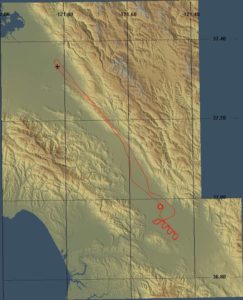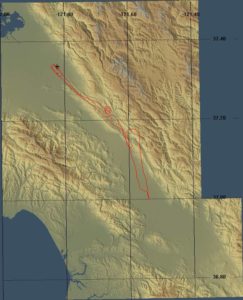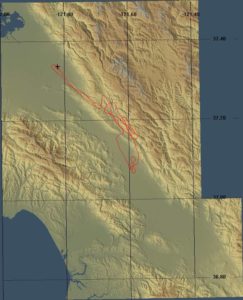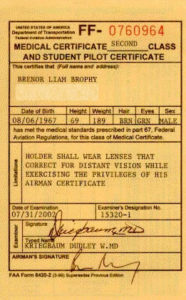Great fight, really relaxing. Another fairly clear California evening. But a lot of haze apparently from fires that are burning in Oregon. The wind was 10knots at heading 300 (I now have the RHV ATIS telephone number programmed in my cell phone and I check it on my way to the airport – that way I know what to expect when I hear it on the radio). Temperature was 28C, 7 miles visibility and clear . This seems to be the standard weather for RHV in the summer. Its certainly nice flying weather.
Grainne decided we should try flying to a different airport this time to practice pattern flying and landing and do some steep turns along the way. Our choices were Livermore or Watsonville. I figured that as Watsonville is near the coast it would be fogged in (as anywhere near the coast is in the summer time here). Grainne called the ASOS which is something like ATIS. Sure enough there was broken cloud cover, so we decided to head for Livermore. This was great because it means I get to fly more or less right over my house for the first time. I went ahead on out to pre-flight N4754D, no problems there. Grainne arrived (and as usual rechecked some of the really critical stuff herself), then we started the pre-taxi checklist. I tried to call, Ground Control to get clearance to taxi and they never heard me. Grainne tried and they didn’t hear her either. Now you may remember that N4754D was the plane we flew that had the radio short circuit just after landing last week. It looks like the combination of me, radio and this plane are fated not to work. The log showed the plane had being flown earlier that day, we assume with no problems. Either way after trying both radios all the mics (mine, Grainne’s and the cabin mic) we decided that we weren’t going to fly 54D today. Back to the office, Grainne looked for another plane and I filled out a squawk sheet for the radio. The out to N5766J which is an old Cessna Skyhawk II. It seemed a little bigger than the other Skyhawks and certainly had bigger seats. We split the pre-flight checks between us and got on our way. In the rush to get flying I forgot to turn on my GPS so that’s why there is no GPS track for today’s flight.
Oh how things change, Grainne actually told me to slow down as I taxied down Zulu. Got all the turns done pretty well, did the radio and ran through the run-up checklist without problems. We were cleared for takeoff on 31R, I got the plane lined up and we took off without a problem. I now seem to have the rudder under control during the takeoff and Grainne actually told me “good takeoff”. This time we were flying more or less North, so its about a 45 degree turn off the runway heading (310 degrees). The Tower has to clear you to make the turn, which needs to happen before you reach interstate 680 – this the boundary of San Jose International Airport Class C airspace. We got clearance and turned for the hills just behind my house on course to pass over Calaveras Reservoir. A nice simple climb up to 4000’ which we reached over the lake. The smoke layer was sitting right at 3000’ and was only about 100’ thick – a light gray horizontal layer just hanging above the tops of the hills. Once you got above it really cut the visibility to the ground in the distance, but didn’t really effect the area close by.
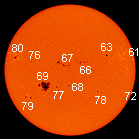 I did a couple of clearing turns and the maneuvering checklist and then Grainne showed me how to make steep turns. These are basically 45 degree turns and they are fun. You bank the plane about 30 degrees, then add a little power (100 rpm) and increase the bank to 45 degrees. You have to apply a reasonable amount of back pressure to keep the nose up and not lose altitude. I did a couple of 360 turns to the left and a couple to the right. I was using the setting Sun as my start finish reference for the turn. After we came out of the second turn lined up with the Sun we were seeing it directly through the smoke layer. It was a deep red and a huge sunspot was clearly visible on the eastern limb. I usually check out the “solar weather” on the web every lunch time. I live in hope of seeing the Northern Lights someday (without a trip to Alaska). I missed them July last year when there was a huge solar storm that pushed them as far South as the Bay Area (I was watching TV and didn’t hear about until after it was over). Anyway, I knew that this was sunspot number 69 and it is the largest one on the Sun’s face at the moment. It was really cool to see it flying an airplane over the Sunol Valley.
I did a couple of clearing turns and the maneuvering checklist and then Grainne showed me how to make steep turns. These are basically 45 degree turns and they are fun. You bank the plane about 30 degrees, then add a little power (100 rpm) and increase the bank to 45 degrees. You have to apply a reasonable amount of back pressure to keep the nose up and not lose altitude. I did a couple of 360 turns to the left and a couple to the right. I was using the setting Sun as my start finish reference for the turn. After we came out of the second turn lined up with the Sun we were seeing it directly through the smoke layer. It was a deep red and a huge sunspot was clearly visible on the eastern limb. I usually check out the “solar weather” on the web every lunch time. I live in hope of seeing the Northern Lights someday (without a trip to Alaska). I missed them July last year when there was a huge solar storm that pushed them as far South as the Bay Area (I was watching TV and didn’t hear about until after it was over). Anyway, I knew that this was sunspot number 69 and it is the largest one on the Sun’s face at the moment. It was really cool to see it flying an airplane over the Sunol Valley.
After the steep turns we headed for Livermore. I contacted the tower and we did a couple of 360 turns to lose altitude in order to enter the traffic pattern at 1400’ MSL (that is Mean Sea Level). We were cleared to land on 25L with left traffic. I did a good 45 degree entry to the pattern, a turn onto the downwind leg, a turn to base and then a turn to final and I was pretty well lined up with the runway. Livermore has a big runway and a little one, 25L is the little one. We did a touch and go which went without a problem. I controlled the steering and the power until just near the end and Grainne took care of the Go part once our wheels touched the ground. We did a crosswind departure (a left turn once we reached 800’) and climbed back to 3500’ for the flight home. I called RHV tower over the Calaveras Reservoir and were given right traffic for runway 31R. Then began the comedy of trying to find the airport through the smoke. I mistook Capitol Expressway for I680 and was looking in completely the wrong place. I’m saying “I can’t see the airport” and Grainne is saying “are you sure, I can see it fine”. I finally looked at her and there was the airport right in front of the right wing clear as a day with all its lights and beacons flashing. I felt a bit stupid. I did another reasonable 45 degree entry into the downwind leg, starting descending abeam the numbers and then a right turn to base and another fairly quickly onto final. I actually turned a bit early onto final and we had to fly a “dog leg” (what Grainne called it), which amounted to flying a bit to the left and then completing the turn onto final lined up with the runway. We were a little high, but not much and the landing was smooth. Grainne is still helping with the flare but I’m really starting to get the feel of it. I’m looking forward to practicing landings. We left the plane run down the runway until the last taxiway exit. This saves on the brakes and it gave me a chance to practice even breaking when the plane is not traveling too fast. We were cleared to taxi directly to the parking area and again I had no problems parking the plane. This taxiing is starting to almost become routine.
Tonight was a lovely flight to spite the problems with the radio’s in 54D. I’m really starting to see my skill progress and starting to gain confidence in my ability to make the plane do what I want. Grainne is off this weekend so I won’t be able to fly until at least next Monday – I can’t wait.

